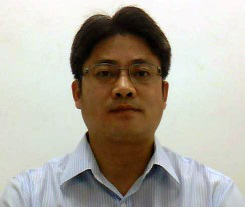应材料科学与工程学院王亚明教授邀请,新加坡国立大学材料科学与工程系Jianyong Ouyang副教授将于1月6日至1月11日对我校进行学术讲座,欢迎全校感兴趣的师生参加。具体学术讲座信息如下:
报告一:Carbon Nanomaterials for Energy Conversion, Electrocatalysis and Wearable Electronics
时间:2019年1月7日(星期一),上午9:00—11:00
地点:哈工大科学园C3栋(特种陶瓷研究所)417报告厅
报告简介:
Carbon nanomaterials including carbon nanotubes and graphene have been attracting great attention because of their interesting structure and properties and important application many areas. These carbon nanomaterials can be directly utilized or through the composite formation with other materials. Here, I will present some of our research works in the application of carbon nanotubes, graphene and graphene oxide for energy conversion and wearable electronics. We developed the gel coating methods to process carbon nanotubes or graphene. Graphene oxide can be used as a binder for the efficient processing of TiO2 nanoparticle pastes. These carbon nanoamterials were investigated as materials in dye-sensitized solar cells, polymer solar cells and electrocatalysis. We also studied their application as stretchable heaters and sensors.
报告二:Flexible Transparent Conductors for Optoelectronics
时间:2019年1月8日(星期二),上午9:00—11:00
地点:哈工大科学园C3栋(特种陶瓷研究所)417报告厅
报告简介:
Optoelectronic devices can harvest or emit light. They require the active material(s) to be sensitive to light and at least one electrode to be transparent. Optoelectronic devices with high mechanical flexibility can have important application in many areas. In addition to the optical and electrical properties, the materials should have high mechanical flexibility. I will present some of our works on the development of intrinsically conductive polymers for the transparent electrode of optoelectronic devices. Indium tin oxide (ITO) is traditionally used as the transparent electrode of optoelectronic devices. But ITO has problems of scarce indium on earth and poor mechanical flexibility. Conducting polymers, carbon nanotubes, graphene and metal wire grids have been proposed to be the transparent electode materials. Among them, poly(3,4-ethylenedioxythiophene):poly(styrenesulfonate) is promising to be the next-generation transparent electrode material due to its solution processability, low cost and high transparency in visible range. However, the as-prepared PEDOT:PSS film obtained from PEDOT:PSS aqueous solution usually has conductivity below 1 S cm-1, remarkably lower than ITO. Here, I will present several novel methods to significantly enhance the conductivity of PEDOT:PSS. The conductivity can be enhanced to be more than 3000 S cm-1, which is higher than that of ITO on plastic and comparable to ITO on glass. We also demonstrate the application of the highly conductive polymers as the transparent electrode of polymer solar cells and perovskite solar cells.
报告三:Flexible Thermoelectric Polymers
时间:2019年1月9日(星期三),上午9:00—11:00
地点:哈工大科学园C3栋(特种陶瓷研究所)417报告厅
报告简介:
Thermoelectric materials can directly convert heat into electricity. There is abundant of low-grade heat on earth but most of them are dissipated to ambient environment as waste heat. The conventional thermoelectric materials are inorganic semiconductors and semi-metals. But those inorganic materials have problems of scarce elements, high cost, high toxicity and poor mechanical flexibility. Thus, thermoelectric polymers have been gaining more and more attention because they consists of common elements like C, O, S and H and have merits of low density, low cost, low thermal conductivity and high mechanical flexibility. In particular, poly(3,4-ethylenedioxythiophene):poly(styrene sulfonate) (PEDOT:PSS) is very promising as the next-generation thermoelectric material because of its addition merit of solution processability. PEDOT:PSS can be dispersed in water and some polar organic solvents, and high-quality PEDOT:PSS films can be readily prepared by solution processing techniques like coating and printing. The main problem for thermoelectric polymers is their low power factor. It is important to develop novel methods to enhance the thermoelectric properties. In this talk, I will present some of our research work in developing high-performance thermoelectric polymers. we observed ae power factor to be >700 mW/(m K2), the highest in the world.
报告四:Organic-Inorganic Perovskite Materials and Solar Cells
时间:2019年1月10日(星期四),上午9:00—11:00
地点:哈工大科学园C3栋(特种陶瓷研究所)417报告厅
报告简介:
Organic-inorganic perovskite solar cells have attracted great attention due to their low fabrication coat and high power conversion efficiency. The high power conversion efficiency is related to high light absorption coefficient and long exciton diffusion length of the perovskite layer. The electronic structure and properties of the perovskite layer depend on the composition of the perovskite materials. We will some our results on perovskite materials and solar cells, including the crystallization of perovskites, the development of highly efficient and/or stable perovskite solar cells through composition engineering and interfacial engineering. We were the first to dope organic-inorganic perovskites with alkali metal ions. We also discovered that two-dimensional materials that can be thermally deposited can be used as efficient interfacial material for electron collection.
Jianyong Ouyang副教授简介:
欧阳建勇,于清华大学化学系、中国科学院化学所和日本分子科学研究所获得学士、硕士和博士学位。然后在日本北陆先端科学技术大学院大学作助理教授和美国加州大学洛杉矶分校作博士后。2006年加入新加坡国立大学材料与科学工程学院,研究方向为有机电子、存储器件、纳米材料等方面的研究,在Nature Materials、Nature Nanotechnology、Nature Communications、Advanced Materials、Nano Letters等学术刊物上发表论文100余篇。多篇研究成果被MIT Technology Reviews、world journal、azonano.com、Nanotechweb、Journal of Materials Chemistry等报道或评为年度亮点文章。他的主要研究成果包括发明了世界上第一个高分子/纳米颗粒存储器和多次刷新可加工导电高分子电导和热电性能的世界记录。平均每篇文章的引用>80次。

Ouyang Jianyong
http://www.mse.nus.edu.sg/staff/ouyang.php
http://www.dmse.nus.edu.sg/ouyanglab/index.html


